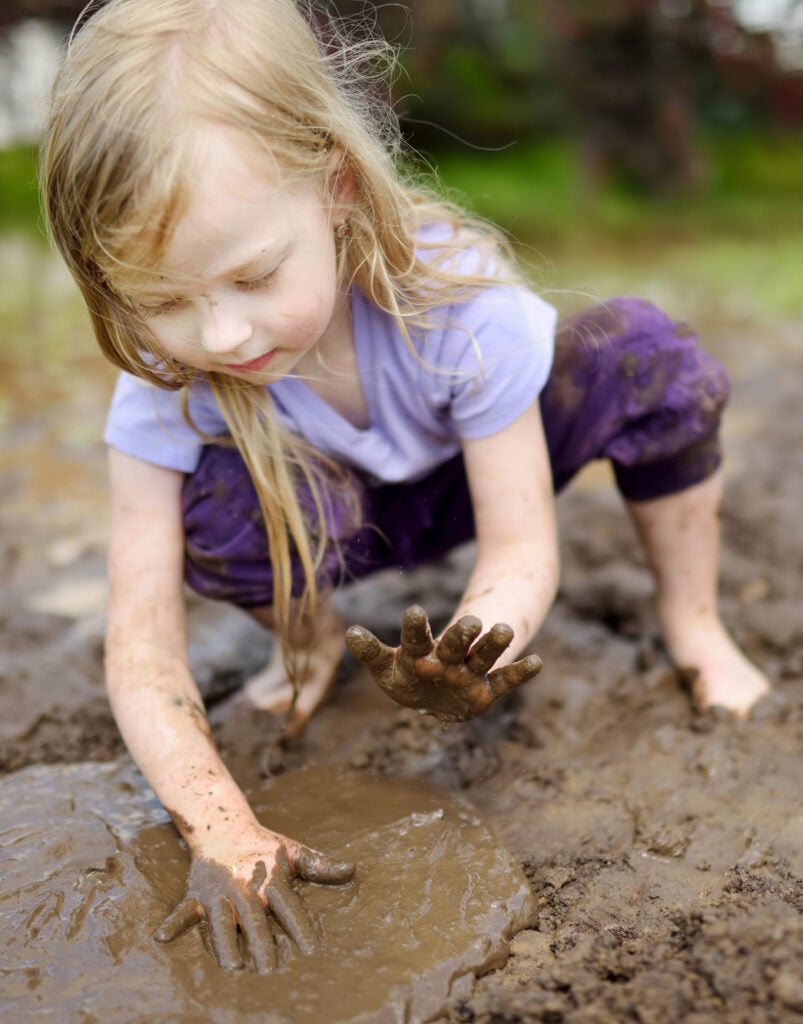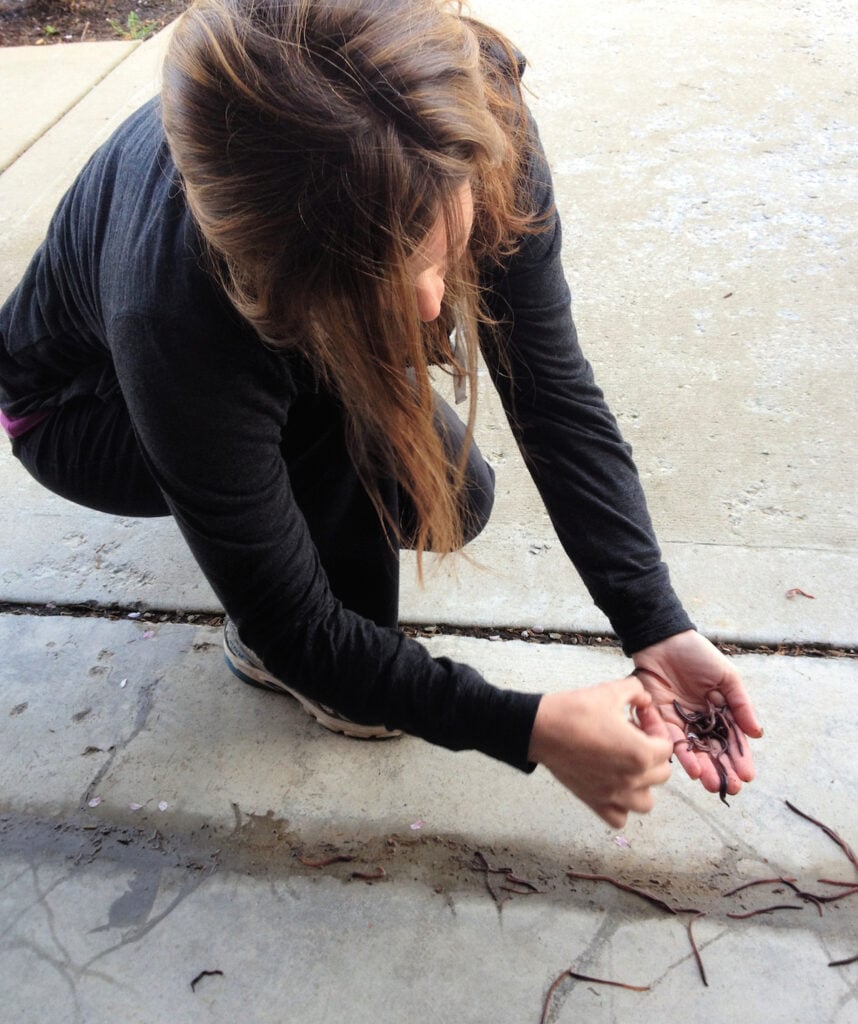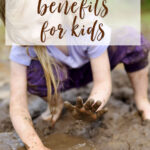The Benefits of Mud Play for Kids
As parents, we usually have enough messes to clean up. So, it may seem counterintuitive to encourage your child to get dirty. But did you know that playing in the mud is healthy for their brains and bodies?
Here, we cover the benefits of mud play for kids and why it’s important to allow children to explore the natural world through their senses.

Playing in the dirt, sand, or mud comes naturally to many kids. But don’t worry – it doesn’t to be as gloppy as the little girl in the photo above to be beneficial!
Why Kids Love Mud Play
You probably have fond memories of messy play as a child. Making mud pies or hills, digging for earth worms, building sand castles, or just splashing in puddles brought our your curiosity. It also satisfied an urge we all have to do things with our hands.
Young children enjoy this type of play because it allows them to
- work with their hands
- be creative
- get messy for a change
- connect with nature
- engage through sensory play
- play with other children
Play is more than just play for kids. It’s how they learn. And it’s always great when something fun is really good for them. Add loads of bonus points when it gets them outside to enjoy nature (and make their messes away from the house).
The Benefits of Mud Play for Kids
Here’s why releasing your own worries about dirt can be so good for your child.
1. Builds a Connection with Nature
I’ve said it dozens of times but it’s worth repeating. We take care of what we love. So if we want kids to grow up to protect the environment, they have to fall in love with it first.
Studies show that time spent in nature is essential for mental health in both the short and long term.
Nature is also calming to a child’s nervous system. It’s the perfect balance to the time we spend using technology. And many of our kids are overstimulated by screens and stress today.
A shovel and a pile of sand or mud can offer hours of independent play where a child has no cares, schedule, or constraints. If just the thought makes your shoulders relax a little, imagine what it can do for your kid.
It can also teach your child compassion for living creatures. I have fond memories of rescuing worms from the driveway after a big rain. As you can see, I still do it today and rush them to my garden.

2. Supports Cognitive and Emotional Development
When kids play in the mud, they engage in imaginative play, which helps develop their creativity and problem-solving skills. They can pretend to be a muddy chef, a construction worker with dump trucks, or a scientist with experiments galore!
These deep play examples are quite different from sitting passively in front of a screen. Tactile play fires and wires more beneficial brain activity for development and creativity.
Mud play also builds problem-solving skills as they figure out how to achieve their artistic vision and navigate which type of dirt makes the best material.
3. Encourages Sensory Exploration
When kids play in the mud, they are exposed to a variety of textures, smells, and sensations. They can squish and shape the mud, which helps develop their fine motor skills and hand-eye coordination.
It also helps stimulate the senses, which can be particularly beneficial for children with sensory processing issues. Kids don’t have to get elbow deep in mud to get the benefits. For a child who is less inclined to get dirty, painting with mud is a great way to ease into nature play.
The feeling of the mud might not appeal to some kids. But this type of sensory play activity is worth trying. It can help desensitize children to certain textures and sensations, which can improve their tolerance for different types of sensory input. Additionally, sensory play can help regulate emotions and reduce stress and anxiety.
4. Boosts the Immune System and Builds the Microbiome
Proper Vitamin D levels can boost immune health and ward off illness. Playing outdoors increases your child’s Vitamin D exposure. The Children’s Hospital of Philadelphia reports, “On a sunny summer day, a child wearing a bathing suit can generate 10,000 to 20,000 international units (IU) of vitamin D after 15 to 30 minutes.”
Vitamin D from the sun is easily synthesized and the body naturally makes just the right amount.
Dirt contains Mycobacterium Vaccae, a type of bacteria that stimulates the immune system and increases the levels of serotonin in the brain. Serotonin is an endorphin that calms the body and helps humans relax.
Mud play also benefits gut health. Any activity that gets a child’s hands in the dirt can help strengthen the immune system by exposing them to natural bacteria and microorganisms.
This exposure can help build a child’s resistance to illness, allergies, and asthma in both the short and long term. In fact, playing in the dirt is one of the top recommendations for building your child’s gut health.
Mud play can help train your child’s immune system. Exposure to various microbes in mud can stimulate the immune system, helping it learn to differentiate between benign substances and harmful pathogens. It also learns not to overreact to harmless substances, reducing the risk of developing allergies or autoimmune conditions.
5. Offers Exercise and Movement
Gathering up dirt and mud takes effort. And have you ever tried to lift buckets of wet sand or bowls of mud? It takes upper body strength. These are all great physical activities that happen naturally while playing in the mud or at an outdoor play station.
Exercise helps protect kids from type 2 diabetes and obesity. It also helps build strong bones and the types of muscles kids can’t get from sitting in front of a screen.
The serotonin boost mentioned above plus all that exercise and fresh air leads to better sleep. There’s nothing like a nice warm bath (to get all the mud off) and snuggling into a cozy bed after a fun-filled day of exploring and creating.
6. Encourages Creativity and Imagination
Mud is nature’s own blank canvas for creativity. Children can mold it into anything they want. Whether it’s a simple mud pie or an elaborate sculpture, their inner artist is in high gear. As you encourage your child’s creativity,
While some other forms of art can feel permanent or intimidating, mud can be sculpted and then squished into a new shape. This helps kids explore the idea of non-attachment. If they don’t like the direction they started, it’s easy to change it up.
Kids can add any toy imaginable to their mud creations. Toy dump trucks and back hoes can help them build roadways in the dirt. Bring other toys outside to encourage more creativity. Just give them a good rinse with the hose when you’re finished.
7. Improves Mental Health
There are two main mental health benefits of playing in the mud. The first is that – like other forms of outdoor play – it reduces anxiety, stress, and anger. A study of nearly one million Danish people showed the positive effects of nature on mental health over time. There are also studies showing that a child’s disconnection from nature can lead to ADHD.
The other involves Mycobacterium Vaccae again. In addition to boosting immunity and serotonin, it also has the ability to reduce stress.
8. Helps Maintain Good Eyesight
A Cambridge University study suggests that every hour spent outdoors each week can reduce a child’s chance of becoming short-sighted by two percent. The children in the study who were short-sighted spent an average of 3.7 fewer hours a week outside compared with those who had normal vision or were long sighted.
Several other studies have found children who spend more time outdoors have a lower risk of myopia. While some report that looking into the distance could be important, others say exposure to outdoor light is key. Either way, playing outside instead of on screens is a great way to reduce digital eye strain, another common vision issue in kids.
Simple Ideas for Mud Play
There are tons of great ideas for mud kitchens but don’t let them overwhelm you. My boys spent plenty of time playing in the dirt, but they never had a designated space. Well, we had a sandbox for a few years but it became too attractive to neighborhood cats.
When my oldest was 10 months old, he loved to get out of his stroller while we were on a walk to throw rocks in a puddle. He would toddle around and find anything that might make a splash. Our walks would take forever if it had rained recently, so we filled old ice cream buckets with water and let him throw rocks in them on the patio. Inevitably, sticks, grass, and dirt would make their way into the mix.
So, you don’t need anything fancy to help your child enjoy the benefits of mud play. Here are some simple ideas.
- Make mud sculptures – sculpt and create anything they like. Feel free to add sticks and pebbles for decoration.
- Get artistic – nature is the perfect backdrop for outdoor mindfulness art activities. See how different types of mud can serve as different “paint,” you can even add nontoxic paints for more color.
- Make mud pies – bring some kitchen utensils outside and help your little chef make “treats” of all kinds. Be sure to supervise little ones so they don’t actually eat their creations.
- Build roads – get their construction toys and build roads or even a mud city for toy cars to drive around.
- Create a fairy house – gather up colorful leaves and beautiful stones to decorate a tiny fairy house.
Your child will probably have dozens of ideas of their own. Follow their lead and let it stay as unstructured as possible. Imagination-led, free play is the goal.
Set a Clean Up Routine
You’ll be more likely to let your child play freely in the mud if there’s a clean up protocol in place. It’s not as much fun to get messy with a helicopter parent hovering the whole time.
Keep clothes and shoes on hand that you don’t mind getting dirty. You might use the same clothing you use for rainy day play.
Just as you have rules or chores for kids inside the house, set a cleanup routine for mud play. Make sure all utensils, bowls, and buckets are put away. Indoor toys like cars or dump trucks should be washed with the hose or bowls of water, dried, and brought back inside. Kids should know how to clean themselves off and where their messy clothes go.
Mud Play FAQs
Children develop their fine motor skills and gross motor skills through mud play. They also build science skills by making before and after comparisons, solving problems, and testing theories. In essence, they learn the scientific method.
They also build math skills by calculating ingredients for the perfect mixtures for mud pies or sculptures. Kids also learn cause and effect. And when they play in the mud together, they build social skills like cooperation, negotiation, communication, and sharing.
Yes. Dirt contains Mycobacterium Vaccae, a type of bacteria that stimulates the immune system and increases the levels of serotonin in the brain. Exposure to dirt builds a more diverse microbiome, leading to better gut and overall health.
The safest dirt for mud play is free from pesticides, insecticides, or possible animal waste. As long as you don’t use chemicals in your yard, the dirt should be fine. But you should always take a look around the play area or mud kitchen to make sure there’s no animal waste or dead animal nearby.
Toddlers and mud are quite the combination! Yes, your toddler will experience all of the benefits of mud play, but you will need to supervise consistently. They might be tempted to eat the mud pie or put their hands in their mouths. While a little dirt won’t hurt (as long as you checked the area beforehand), ingesting more than a little could lead to a bacterial infection.
For plenty of inspiration on mud play, check out these mud kitchen ideas next.

